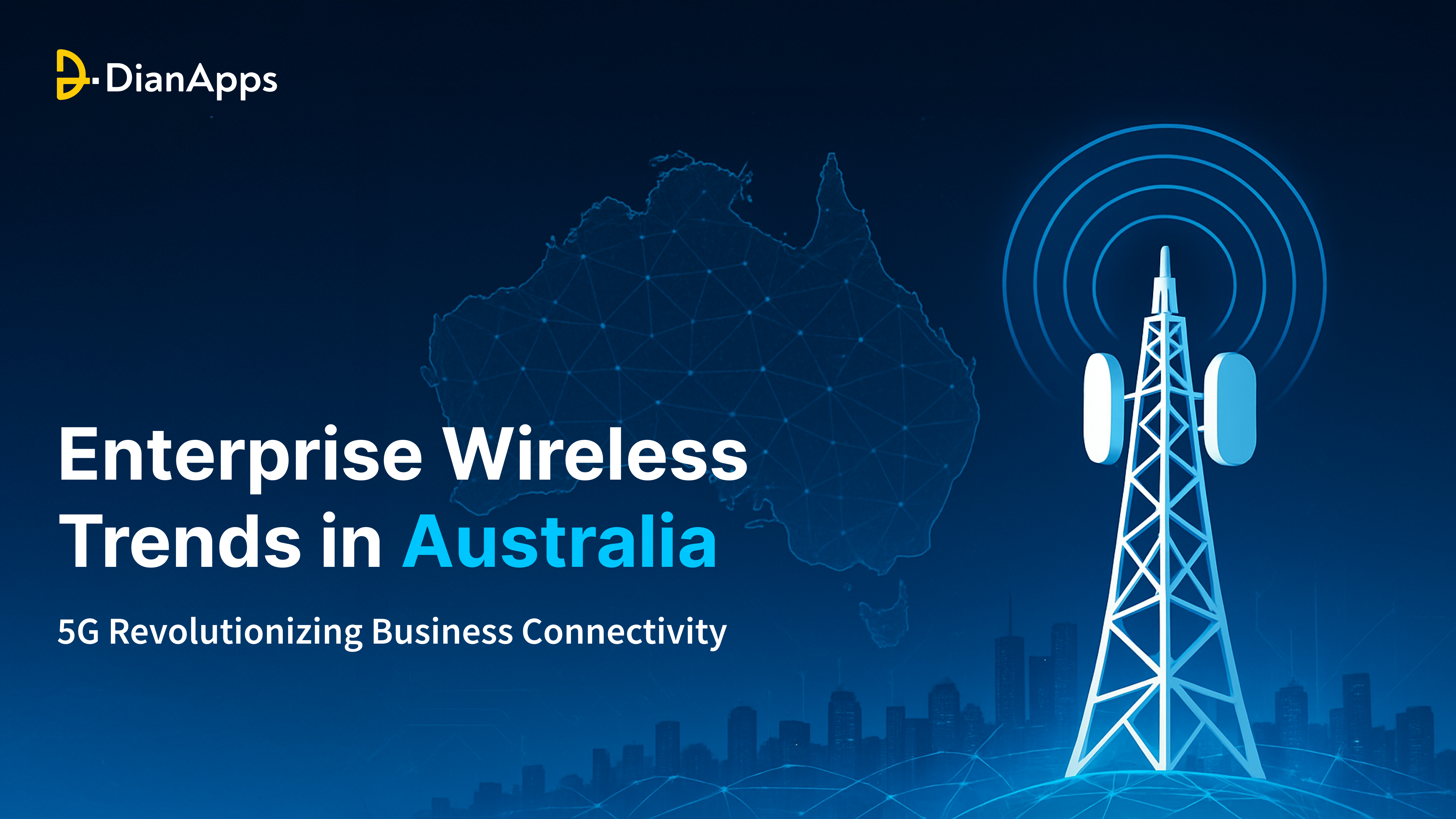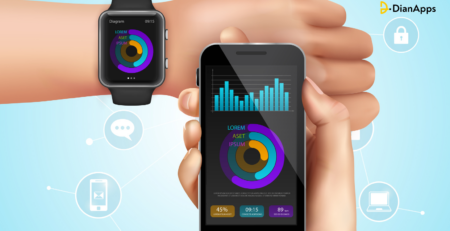Enterprise Wireless Trends in Australia: 5G Revolutionizing Business Connectivity
You’re not just running a business anymore, you’re navigating a digital battlefield where speed, connectivity, and real-time responsiveness decide who leads and who lags behind.
Across Australia, enterprise wireless technology is undergoing a massive shift, and 5G is at the heart of it. It’s not just a telecom upgrade; it’s the infrastructure powering the next wave of digital transformation.
Read how to find the best digital transformation partner?
From the smart warehouses of Melbourne to cloud-powered offices in Sydney and AI-driven logistics hubs in Brisbane, 5G is redefining how Australian businesses operate, scale, and compete.
Gone are the days when slow connections in mobile app development services were just a minor inconvenience. In today’s landscape, they cost productivity, clients, and growth.
That’s why forward-thinking businesses are already embracing 5G-powered enterprise connectivity, to unlock faster communication, smarter operations, and unparalleled flexibility.
In this blog, we uncover the top wireless trends revolutionizing Australian enterprises, explore how 5G is reshaping business connectivity, and help you understand what’s coming next, so your business doesn’t just keep up but gets ahead.
The Current State of Enterprise Wireless in Australia
Australia’s enterprise landscape has seen a dramatic shift in wireless adoption over the past few years. With the acceleration of digital transformation and remote work, businesses have increasingly moved away from traditional wired networks, embracing wireless technologies that offer agility, mobility, and scalability.
While the National Broadband Network (NBN) laid the foundation for improved internet access, many enterprises still faced limitations in bandwidth, latency, and flexibility, especially in regional areas.
Wi-Fi networks remained the default for in-building connectivity, but they often struggled under the pressure of modern cloud applications, video conferencing, and real-time collaboration tools.
That’s where enterprise-grade mobile connectivity, primarily via 4G LTE, stepped in as a stop-gap. But as business demands outpaced the capabilities of 4G, the Australian market began preparing for something far more robust.
Today, with 5G rollouts underway in major cities and regional hubs, the wireless ecosystem is reaching a critical turning point. Enterprises are no longer asking if they should switch to advanced wireless solutions, they’re asking how fast they can make it happen.
Rise of 5G in Australia
The 5G rollout in Australia is more than a network upgrade, it’s a nationwide infrastructure shift that’s enabling real-time business, automation, and digital scale like never before. Spearheaded by telecom giants like Telstra, Optus, and TPG Telecom, 5G coverage is rapidly expanding across metropolitan areas, industrial zones, and even selected regional corridors.
Where We Stand Today
As of 2025, Telstra leads the market with widespread 5G availability in over 85% of the population. Optus and TPG follow closely, focusing on both urban business districts and strategic regional expansions. Key cities such as Sydney, Melbourne, Brisbane, Adelaide, and Perth are already enjoying ultra-fast 5G speeds, while mining regions, ports, and agricultural zones are seeing tailored 5G deployments for industrial use.
What Makes 5G a Game-Changer for Enterprises?
- Speeds up to 10x faster than 4G, making lag a thing of the past
- Ultra-low latency (<1 millisecond), essential for real-time applications
- Massive device support, enabling IoT ecosystems and smart operations
- Network slicing, allowing enterprises to build private, secure wireless environments
Unlike previous generations of mobile technology, 5G is built with enterprise use in mind. It isn’t just about browsing faster, it’s about transforming how businesses operate across every layer: communication, automation, analytics, and service delivery.
Australia’s readiness to embrace this shift is evident. From smart city initiatives in Adelaide to autonomous mining in Western Australia, 5G is impacting greatly on mobile apps and becoming the technological backbone of progressive industries.
How 5G Is Revolutionizing Business Connectivity?
The promise of 5G goes far beyond faster downloads. It’s a paradigm shift in how businesses connect people, devices, and data. In the Australian enterprise landscape, 5G is enabling new operational models, unlocking real-time intelligence, and reshaping entire industries.
a. Empowering Remote Work & Seamless Collaboration
With hybrid work here to stay, 5G is bridging the gap between teams, no matter where they are.
- Crystal-clear video conferencing without lag
- Real-time collaboration across cloud tools and enterprise apps
- Mobile-first workforces with stable connectivity on the go
Startups, SMEs, and large enterprises alike are finding that 5G enhances productivity in ways traditional Wi-Fi or 4G networks simply can’t match.
b. Enabling Smart Operations with IoT & Automation
From smart farms in rural Queensland to automated ports in Sydney, 5G is fueling the rise of the Internet of Things (IoT).
- Instant communication between devices (sensors, cameras, drones, robotics)
- Real-time monitoring, analytics, and decision-making
- Industry-specific gains in logistics, healthcare, mining, and agriculture
These innovations are not theoretical, Australian businesses are already using them to cut costs, improve efficiency, and boost ROI.
Read the future of IoT, Bots, and Mobile Apps
c. Private 5G Networks for Enterprise Control
Enterprises with high-security or high-performance needs, like hospitals, universities, airports, and manufacturing plants, are deploying private 5G networks.
- Fully dedicated and secure wireless environments
- Optimised for mission-critical operations
- Custom-built coverage in large facilities
This trend is gaining traction in Australia, especially in sectors that require reliability and data privacy without compromising speed.
d. Fueling Cloud, AI, and Edge Computing
5G enables businesses to leverage cloud platforms and AI tools more efficiently by reducing latency and improving bandwidth.
- Edge computing allows for real-time data processing at the source
- AI and machine learning applications become faster and smarter
- Businesses can deliver personalised experiences at scale
Together, 5G + Cloud + Edge = a powerhouse trio that’s transforming customer service, analytics, and digital innovation across Australia.
Key Wireless Trends Shaping Enterprise Tech in Australia
As 5G lays the foundation for smarter business infrastructure, several wireless trends are emerging across Australia’s enterprise landscape. These trends are reshaping how companies approach connectivity, innovation, and digital operations in a hyper-competitive environment.
a. Wi-Fi 6 and Wi-Fi 6E in Enterprise Environments
While 5G grabs headlines, Wi-Fi 6 and the newly introduced Wi-Fi 6E are making in-building networks faster and more efficient than ever.
- Improved performance in high-density environments like offices and campuses
- Lower latency and higher throughput
- Enhanced power efficiency for connected devices
Australian enterprises are increasingly combining Wi-Fi 6 with 5G to create hybrid wireless networks that offer the best of both worlds.
b. Rise of 5G-Powered SD-WAN Solutions
Software-defined wide area networks (SD-WAN) are being supercharged by 5G.
- Enhanced network reliability and real-time traffic control
- Dynamic routing between cloud platforms, branch offices, and remote workers
- Cost-effective alternative to traditional MPLS networks
This is particularly beneficial for multi-location businesses, retail chains, and logistics providers operating across regional Australia.
c. eSIM Technology & Mobile-First Business Models
eSIMs are making it easier for businesses to deploy and manage fleets of connected devices.
- Remote provisioning and management
- Ideal for IoT sensors, smartphones, and connected machinery
- Lower operational friction and increased scalability
As mobile-first strategies gain traction, eSIM-enabled 5G devices are becoming a central part of enterprise mobility.
d. AI-Driven Network Management
AI and machine learning are being integrated into wireless networks for proactive monitoring, optimization, and security.
- Predictive analytics for network traffic and performance
- Automated threat detection
- Self-healing networks with minimal downtime
Australian enterprises are embracing AI-powered connectivity to reduce IT overhead and enhance network resilience.
Challenges and Considerations for Businesses
While 5G and modern wireless technologies offer immense potential, the road to adoption isn’t without its hurdles. Australian enterprises, particularly those in regional areas or highly regulated industries, must address key challenges before fully capitalising on this wireless revolution.
a. Infrastructure Investment & Deployment Costs
Implementing 5G-ready infrastructure or private networks often requires significant upfront investment.
- Cost of upgrading routers, modems, and device fleets
- Deployment of small-cell networks in dense office environments
- ROI timelines vary depending on industry and scale
Small to medium enterprises may need to balance innovation with cost-efficiency, exploring phased rollouts or partnerships with telecom providers.
b. Cybersecurity and Regulatory Compliance
As more devices and systems go wireless, cybersecurity risks multiply.
- Sensitive enterprise data transmitted over mobile networks
- Complex compliance requirements (such as data sovereignty and industry-specific laws)
- Need for advanced encryption, endpoint security, and regular audits
In Australia, businesses must align with ACSC (Australian Cyber Security Centre) guidelines while also keeping an eye on global standards.
c. Urban-Rural Connectivity Divide
Despite ongoing efforts, regional and remote businesses still face challenges accessing consistent 5G coverage.
- Network expansion is uneven across states and territories
- Regional industries (farming, mining, transport) often rely on hybrid connectivity model
- Support from government initiatives like the Mobile Black Spot Program is helping but not yet universal
This digital divide can limit innovation for businesses based outside of major metro hubs unless addressed through customised connectivity planning.
d. Skill Gaps & Tech Readiness
Adopting 5G and related technologies requires skilled IT teams and change-ready leadership.
- Network engineers, cybersecurity experts, and cloud architects are in high demand
- Ongoing training is essential to fully leverage wireless potential
- Businesses must ensure teams are equipped to manage new infrastructures and workflows
These challenges are not dealbreakers, but they are critical factors for businesses aiming to make informed, future-proof decisions in their connectivity roadmap.
Future Outlook: What’s Next for Australian Enterprises?
The evolution of enterprise wireless in Australia is just getting started. As adoption of 5G accelerates and new technologies emerge, the future of business connectivity is set to become more intelligent, decentralised, and experience-driven.
a. From 5G to 5G Advanced and Beyond
By 2026 and beyond, Australian telcos are expected to begin transitioning into 5G Advanced, a mid-phase upgrade that brings:
- Even lower latency
- Higher reliability for critical services
- Support for network automation and AI-native networks
This evolution paves the way for industries like autonomous transportation, remote surgeries, and smart city grids.
b. Rise of Industry-Specific 5G Use Cases
Expect to see hyper-targeted wireless solutions tailored for key Australian sectors:
- Mining & Energy: Autonomous vehicles and drones powered by private 5G networks
- Healthcare: Real-time diagnostics and connected medical devices
- Agriculture: Precision farming tools using IoT sensors and edge analytics
- Retail & Events: Immersive customer experiences through AR/VR and spatial computing
c. Telecom + Tech Ecosystem Partnerships
We’ll also witness more collaborations between telcos, cloud providers, and IT consultancies to deliver end-to-end wireless solutions.
This means businesses won’t just be buying data plans, they’ll be investing in strategic connectivity ecosystems that evolve with them.
d. Focus on Sustainability and Green Networking
As pressure builds around climate responsibility, expect a stronger push toward energy-efficient wireless infrastructure and carbon-neutral network strategies, especially within Australia’s ESG-driven corporate landscape.
How Businesses Can Prepare Today?
With 5G rapidly transforming the connectivity landscape, now is the time for Australian enterprises to act, not react. Businesses that proactively prepare for this wireless shift will be better positioned to drive innovation, improve operations, and stay ahead of their competition.
a. Evaluate Your Current Connectivity Infrastructure
Start with a wireless audit:
- Are your systems 5G-ready?
- Do you rely heavily on outdated wired or 4G networks?
- Is your existing network secure, scalable, and capable of handling real-time data?
Understanding your current state helps you plan the right upgrades with minimal disruption.
b. Invest in 5G-Compatible Devices & Platforms
Future-proof your tech stack:
- Upgrade to devices that support 5G and Wi-Fi 6
- Ensure business applications (CRMs, collaboration tools, cloud platforms) are optimised for low-latency networks
- Consider SD-WAN solutions to support multiple locations and remote teams
c. Partner with Trusted Connectivity Providers
Choose telecom partners who offer:
- Customised enterprise solutions
- Private 5G network capabilities
- Secure integration with cloud, IoT, and edge services
Look for providers with proven experience in your industry vertical, not just the tech itself.
d. Upskill Your Team
Train your workforce to:
- Manage and maintain 5G infrastructure
- Handle data security and compliance in real-time environments
- Innovate with connected tools like IoT, edge AI, and cloud analytics
This isn’t just about IT, all departments need to understand the impact of wireless transformation.
e. Plan for Scalability
Design your wireless strategy to grow with your business. That means:
- Modular infrastructure
- Flexible network management tools
- Backup solutions to ensure uptime and continuity
Businesses that build with scale in mind will be better prepared to adapt as 5G technology continues to evolve.
Conclusion
The wireless revolution is no longer on the horizon, it’s happening now, and 5G is leading the charge across Australia’s enterprise landscape.
As connectivity moves from being a support system to a core driver of business performance, companies that embrace next-gen wireless technologies will unlock new levels of speed, intelligence, and innovation.
From empowering remote teams and deploying IoT at scale to building private, high-security networks, the impact of 5G on Australian businesses is profound and permanent. The question isn’t whether your enterprise should adopt it, it’s how soon you can start.
For companies ready to lead, the next step is clear: Assess. Upgrade. Partner. Scale. Because as a custom software development company we believe in a 5G-powered future, it’s not just about staying connected, it’s about staying competitive.




